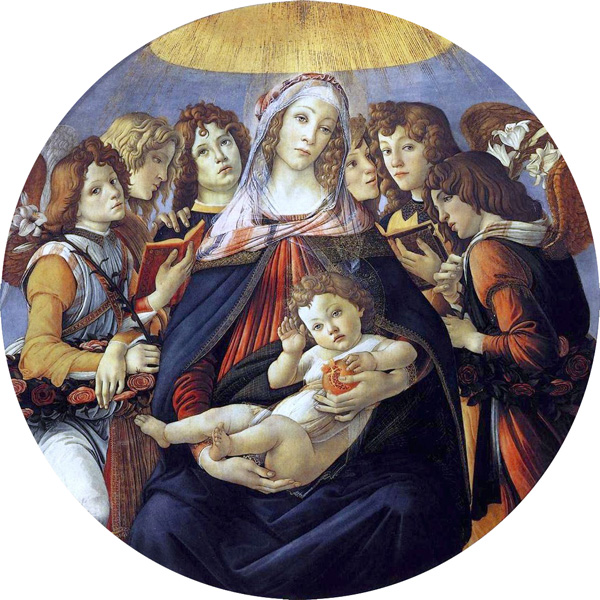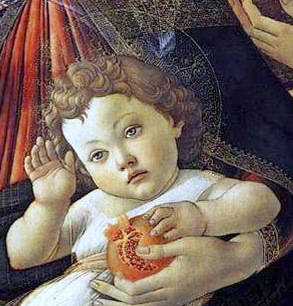Sandro Botticelli was an Italian painter from the early Renaissance. He was a true master.
Botticelli’s best known works are The Birth of Venus and Primavera. In both masterpieces the lighting is ambient (coming from all directions). Shadows, for the most part, are absent. This gives the sense that the subjects in the painting are light and graceful. One feels like they are caught in another dimension. A dimension that is free of gravity. These two paintings contain Christian symbolism, as well as elements from Roman mythology. This unusual juxtaposition creates a bit of mystery in these two works, especially Primavera. So much so that the paintings true meanings are still somewhat masked.
Biographies of Botticelli characterize him as a devout Catholic, whose faith became deeper, and more reflective towards the end of his life.
Botticelli created tondos, like Hieronymus Bosch. As mentioned in the last post, the Italian word “tondo” is used to describe something round or circular. It’s also used to describe Renaissance circular words of art, which is the period both Botticelli and Bosch belonged to. Other artists from the time, such as Michelangelo, created tondos as well.
The difference between a tondo and a Christian mandala is that a tondo is merely a circular composition. A Christian Mandala has a central subject to which all other elements of the circle relate. Additionally, Christian symbolism may be more prevalent in the case of a mandala.
Some notable Botticelli tondos include: The Adoration of the Magi, The Madonna of the Magnificat, Madonna Adoring the Child with Five Angels, Virgin and Child with the Infant St. John the Baptist, and Madonna of the Pomegranate.
Botticell’s tondos flirt with the mandala concept. Personally, I consider Madonna of the Pomegranate, shown above, and The Adoration of the Magi tondo to be Christian mandalas.
In the center of Madonna of the Pomegranate, is the head of Christ as a baby. Around his head (a bit hard to see) is a small, golden circle known as a nimbus. The nimbus identifies to divinity of the child Jesus. Mary is holding the child, and has three angels on either side of her, for a total of six.
The composition contains a number of Christian symbols.
The angels hold books and lilies. The books are symbolic for the word of God, and the lilies have a two-fold symbolism. First, they symbolize Mary. Second, they symbolize Christ’s resurrection. In addition, the angels also hold red roses. These roses also have a double meaning, symbolizing both the nativity of Christ, and martyrdom.
The last, and most important, symbolic element in this piece is the pomegranate. The baby Jesus, aided by Mary, holds the pomegranate directly over his heart. The piece of fruit is torn open, revealing the red seeds inside. This gives the sense of a wounded Christ, pouring out His body and blood for us. Additionally, if you look in the tear in the pomegranate, beyond the red seeds, we see the white walls of the fruit. They separate the sections of the fruit, depicted as five white, radial lines. Five is symbolic of the wounds Jesus received on the cross, emphasizing Christ’s sacrifice.
In Christian symbolism, the pomegranate is generally a symbol of the Church. However, when the pomegranate is held by Jesus, it also symbolizes the resurrection.
Therefore, we have a Christian mandala describing Jesus’ incarnation, sacrifice, and resurrection. Very appropriate as we approach Easter.


